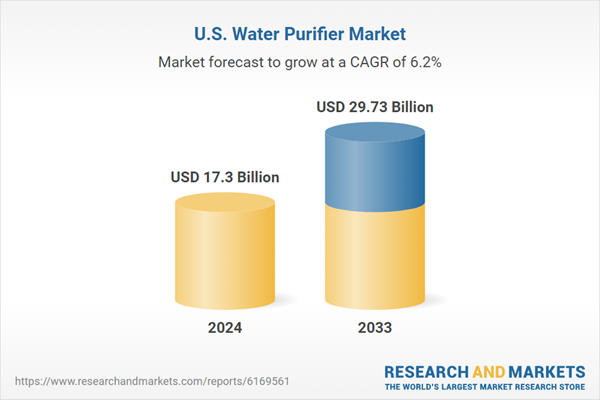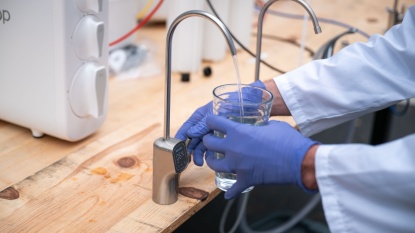United States Water Purifier Market Report 2025-2033: – GlobeNewswire

United States Water Purifier Market: A Report on Growth, Drivers, and Alignment with Sustainable Development Goals (2025-2033)
Market Overview and Projections
The United States Water Purifier Market is projected to experience significant growth, expanding from an estimated value of US$ 17.30 Billion in 2024 to US$ 29.73 Billion by 2033. This expansion represents a Compound Annual Growth Rate (CAGR) of 6.20% for the period from 2025 to 2033. The market’s trajectory is influenced by rising public awareness of water quality, health implications of contaminated water, and continuous technological advancements in purification methods.
Alignment with Sustainable Development Goals (SDGs)
The growth and innovation within the U.S. water purifier market are directly contributing to several United Nations Sustainable Development Goals (SDGs), particularly those focused on health, clean water, and responsible consumption.
SDG 3: Good Health and Well-being
Water purifiers are instrumental in safeguarding public health by removing harmful microorganisms, heavy metals like lead, and chemical contaminants such as PFAS. By ensuring access to safe drinking water at the point of use, the market directly supports the goal of reducing illnesses and promoting overall well-being for all ages.
SDG 6: Clean Water and Sanitation
The market addresses critical gaps in achieving universal access to safe drinking water. Public concerns over the reliability of municipal water systems, highlighted by crises in locations like Flint, Michigan, underscore the role of household purifiers in providing a final barrier against contaminants, thereby helping to achieve the target of safe and affordable drinking water for all.
SDG 12: Responsible Consumption and Production
The adoption of in-home water purification systems promotes sustainable consumption patterns by reducing reliance on single-use plastic bottled water. This shift significantly curtails plastic waste and supports the goal of sustainable resource management. Furthermore, technological innovations focusing on energy-efficient models and recyclable filter components enhance the market’s contribution to this SDG.
Key Market Drivers
Water Quality and Contamination Concerns
A primary driver for market growth is the heightened public concern over water contamination. Issues related to lead, chlorine, microbial contaminants, and per- and polyfluoroalkyl substances (PFAS), often referred to as “forever chemicals,” are compelling consumers to seek reliable purification solutions. Regulatory actions and public health advisories from bodies like the EPA have amplified this awareness, leading to increased adoption of advanced filtration systems such as reverse osmosis (RO), UV, and activated carbon filters.
Growing Health and Wellness Consciousness
There is a rising trend among U.S. consumers to prioritize health and wellness, with a specific focus on quality hydration. Purified water is increasingly viewed as essential for preventing gastrointestinal issues and maintaining overall health. This trend is particularly strong among families with children and elderly individuals, who are investing in advanced purification technologies to ensure water safety.
Technological Innovation and Smart Systems
Technological advancements are revolutionizing the water purifier market, aligning with SDG 9: Industry, Innovation, and Infrastructure. Key innovations include:
- Multi-stage purification processes for comprehensive contaminant removal.
- IoT-enabled smart purifiers that provide real-time water quality monitoring and filter replacement alerts via mobile apps.
- Development of energy-efficient systems, such as Amway’s 2024 eSpring model featuring UV-C LED technology, which reduces energy consumption.
- Introduction of sustainable features like recyclable filters and reduced plastic usage in device construction.
Market Challenges
High Initial Investment and Maintenance Costs
The high upfront cost of advanced purification systems, such as RO and UV units, remains a significant barrier, particularly for low- and middle-income households. Ongoing maintenance, including periodic filter replacement, adds to the total cost of ownership, making less expensive alternatives like bottled water more appealing to price-sensitive consumers.
Consumer Awareness and Trust Deficits
Despite growing concerns, a segment of the consumer base lacks detailed awareness of the specific benefits of advanced purification technologies over basic filters. Inconsistent product performance and misleading marketing claims from some manufacturers have created trust issues. Overcoming these barriers requires extensive consumer education on the long-term health and economic benefits of reliable water purification.
Market Segmentation Analysis
By Technology
- RO Purifier
- UV Purifier
- Gravity Purifier
- Others
By Distribution Channel
- Retail Stores
- Direct Sales
- Online
By End User
- Commercial
- Residential
Key Market Players
The market features several prominent companies driving innovation and competition. An analysis of key players includes an overview, recent developments, and revenue analysis for the following corporations:
- Panasonic Corporation
- Honeywell International Inc.
- AO Smith Corporation
- Unilever Plc
- Pentair
- Helen of Troy Limited
- Koninklijke Philips N.V
- 3M Corporation
1. Which SDGs are addressed or connected to the issues highlighted in the article?
-
SDG 3: Good Health and Well-being
- The article directly connects the use of water purifiers to safeguarding public health. It states that a primary application is “removing dangerous microorganisms and heavy metals that can cause serious illnesses.” It also mentions that purified water is seen as “crucial to avoiding gastrointestinal disease, enhancing skin well-being, and ensuring overall health.”
-
SDG 6: Clean Water and Sanitation
- This is the central SDG addressed. The entire article revolves around the need for and market growth of water purifiers due to a lack of trust in municipal water safety. It highlights issues like the “Flint, Michigan, crisis” and the presence of contaminants such as “lead, chlorine, PFAS (forever chemicals)” as key drivers, pointing to a need for access to safe drinking water.
-
SDG 9: Industry, Innovation, and Infrastructure
- The article emphasizes the role of “technological innovation” in the water purifier market. It details advancements like “multi-stage purification, intelligent sensors, IoT-based monitoring,” and specifically mentions a new purifier with “UV-C LED technology” that “uses 25% less energy,” showcasing the development of more efficient and sustainable technology.
-
SDG 12: Responsible Consumption and Production
- The article highlights the environmental benefit of water purifiers in promoting sustainable consumption patterns. It explicitly states that purifiers help in “ensuring sustainability and minimizing plastic waste” by providing an alternative to bottled water. One product is noted to be able to “replace 10,000 individual-use plastic water bottles.”
-
SDG 10: Reduced Inequalities
- The article touches upon this goal by identifying a key challenge: “High Initial Investment and Maintenance Charges.” It notes that the high cost of advanced purifiers deters “middle- and low-income groups,” creating a disparity in access to safe water technology based on economic status.
2. What specific targets under those SDGs can be identified based on the article’s content?
-
Target 3.9: By 2030, substantially reduce the number of deaths and illnesses from hazardous chemicals and air, water and soil pollution and contamination.
- The article aligns with this target by focusing on the removal of “dangerous microorganisms,” “heavy metals,” “lead, chlorine, PFAS,” “PFOA and PFOS” from drinking water, all of which are contaminants that can cause serious illnesses.
-
Target 6.1: By 2030, achieve universal and equitable access to safe and affordable drinking water for all.
- The article’s discussion of widespread contamination concerns (affecting “26 million individuals”) directly relates to the need for “safe” drinking water. Furthermore, it addresses the “affordable” aspect by highlighting that high costs are a significant barrier for many households, preventing equitable access.
-
Target 9.4: By 2030, upgrade infrastructure and retrofit industries to make them sustainable, with increased resource-use efficiency and greater adoption of clean and environmentally sound technologies.
- The mention of new purifiers with “UV-C LED technology” that “uses 25% less energy” and has a longer service life is a direct example of adopting more resource-efficient and environmentally sound technology, as called for in this target.
-
Target 12.5: By 2030, substantially reduce waste generation through prevention, reduction, recycling and reuse.
- This target is addressed through the article’s emphasis on water purifiers as a tool for waste prevention. The text states they help in “minimizing plastic waste” from single-use bottles, with one device capable of replacing “10,000 individual-use plastic water bottles.”
3. Are there any indicators mentioned or implied in the article that can be used to measure progress towards the identified targets?
-
Indicator for Water Contamination Levels (Targets 3.9 and 6.1)
- The article provides specific data points that can serve as indicators of the problem’s scale. It states that “approximately one in 10 drinking water systems are contaminated, affecting approximately 26 million individuals.” The presence of specific chemicals like “PFOA and PFOS” also serves as a direct indicator of water quality.
-
Indicator for Waste Reduction (Target 12.5)
- A quantifiable indicator is explicitly mentioned: the capacity of a new purifier to “replace 10,000 individual-use plastic water bottles.” This metric directly measures the prevention of plastic waste generation.
-
Indicator for Energy Efficiency (Target 9.4)
- The article provides a specific metric for technological improvement: a new purifier model “uses 25% less energy.” This is a direct indicator of increased energy efficiency in purification technology.
-
Indicator for Market Adoption (Implied for all targets)
- The market growth forecast, from “US$ 17.30 Billion in 2024 to US$ 29.73 Billion in 2033,” can be used as an indirect indicator of the population’s increasing adoption of purification technologies to address health, safety, and environmental concerns.
4. Table of SDGs, Targets, and Indicators
| SDGs | Targets | Indicators |
|---|---|---|
| SDG 3: Good Health and Well-being | Target 3.9: Substantially reduce illnesses from hazardous chemicals and water contamination. | Presence of specific contaminants in water sources, such as “dangerous microorganisms,” “heavy metals,” “PFOA and PFOS.” |
| SDG 6: Clean Water and Sanitation | Target 6.1: Achieve universal and equitable access to safe and affordable drinking water. | The proportion of the population affected by contaminated water systems (e.g., “approximately 26 million individuals”). |
| SDG 9: Industry, Innovation, and Infrastructure | Target 9.4: Upgrade infrastructure and adopt clean and environmentally sound technologies. | Percentage reduction in energy consumption by new technologies (e.g., a purifier that “uses 25% less energy”). |
| SDG 12: Responsible Consumption and Production | Target 12.5: Substantially reduce waste generation through prevention and reduction. | The number of single-use plastic items replaced by a durable alternative (e.g., a purifier that can “replace 10,000 individual-use plastic water bottles”). |
| SDG 10: Reduced Inequalities | Target 10.2: Empower and promote the inclusion of all, irrespective of economic status. | Disparities in technology adoption based on income levels (e.g., high costs deterring “middle- and low-income groups”). |
Source: globenewswire.com
What is Your Reaction?
 Like
0
Like
0
 Dislike
0
Dislike
0
 Love
0
Love
0
 Funny
0
Funny
0
 Angry
0
Angry
0
 Sad
0
Sad
0
 Wow
0
Wow
0
















































/environment-climate-change-and-health-(ech)/water-sanitation-hygiene-and-health-(wsh)/landfill-tuvalu-36092.tmb-1200v.jpg?sfvrsn=5c21fe40_1#)

.jpg.webp?itok=0ZsAnae9#)

























